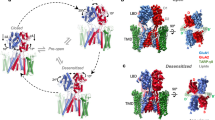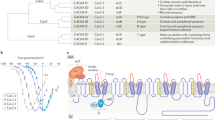Abstract
Fast synaptic transmission depends on the selective ionic permeability of transmitter-gated ion channels. Here we show changes in the ion selectivity of neuronal P2X transmitter-gated cation channels as a function of time (on the order of seconds) and previous ATP exposure. Heterologously expressed P2X2, P2X2/P2X3 and P2X4 channels as well as native neuronal P2X channels possess various combinations of mono- or biphasic responses and permeability changes, measured by NMDG+ and fluorescent dye. Furthermore, in P2X4 receptors, this ability to alter ion selectivity can be increased or decreased by altering an amino-acid residue thought to line the ion permeation pathway, identifying a region that governs this activity-dependent change.
This is a preview of subscription content, access via your institution
Access options
Subscribe to this journal
Receive 12 print issues and online access
$209.00 per year
only $17.42 per issue
Buy this article
- Purchase on Springer Link
- Instant access to full article PDF
Prices may be subject to local taxes which are calculated during checkout








Similar content being viewed by others
References
Burnstock, G. Purinergic nerves. Pharmacol. Rev. 24, 509–581, (1972).
Evans, R. J., Derkach, V. & Surprenant, A. ATP mediates fast synaptic transmission in mammalian neurons. Nature 357, 503– 505 (1992).
Edwards, F. A., Gibb, A. & Colquhoun, D. ATP receptor-mediated synaptic currents in the central nervous system. Nature 359, 144– 146 (1992).
Galligan, J. J. & Bertrand, P. P. ATP mediates fast synaptic potentials in enteric neurons. J. Neurosci. 14, 7563–7571 (1994).
Bardoni, R., Goldstein, P. A., Lee, J., Gu, J. G. & MacDermott, A. B. ATP P2X receptors mediate fast synaptic transmission in the dorsal horn of the rat spinal cord. J. Neurosci. 17, 5297–5304 (1997).
Nieber, K., Poelchen, W. & Illes, P. Role of ATP in fast excitatory synaptic potentials in locus coeruleus neurons of the rat. Br. J. Pharmacol. 122, 423–430 (1997).
Surprenant, A., Buell, G. & North, R. A. P2X receptors bring new structure to ligand-gated ion channels. Trends Neurosci. 18, 224– 229 (1995).
Gu, J. G. & MacDermott, A. B. Activation of ATP P2X receptors elicits glutamate release from sensory neurone synapses. Nature 389, 749–753 (1997).
Khakh, B. S. & Henderson, G. ATP receptor-mediated enhancement of fast excitatory neurotransmitter release in the brain. Mol. Pharmacol. 54, 372–378 (1998).
Wieraszko, A., Goldsmith, G. & Seyfried, T. N. Stimulation-dependent release of adenosine triphosphate from hippocampal slices. Brain Res. 485, 244–250 (1989).
Cunha, R. A., Vizi, E. S., Ribeiro, J. A. & Sebastiao, A. M. Preferential release of ATP and its extracellular catabolism as a source of adenosine upon high- but not low-frequency stimulation of rat hippocampal slices. J. Neurochem. 67, 2180– 2187 (1996).
Terrian, D. M., Hernandez, P. G., Rea, M. A. & Peters, R. I. ATP release, adenosine formation, and modulation of dynorphin and glutamic acid release by adenosine analogues in rat hippocampal mossy fiber synaptosomes. J. Neurochem. 53, 1390– 1399 (1989).
Lutz, P. L. & Kabler, S. Release of adenosine and ATP in the brain of freshwater turtle (Trachemys scripta) during long term anoxia. Brain Res. 769, 281–286 (1997).
Braun, N., Zhu, Y., Krieglstein, J., Culmsee, C. & Zimmermann, H. Upregulation of the enzyme chain hydrolysing extracellular ATP after transient forebrain ischaemia in the rat. J. Neurosci. 18, 4891–4900 (1998).
North, R. A. Families of ion channels with two hydrophobic segments. Curr. Opin. Cell Biol. 8, 474–483 (1996).
Green, T., Heinemann, S. F. & Gusella, J. F. Molecular neurobiology and genetics: investigation of neural function and dysfunction. Neuron 20, 427–444 (1998).
Kidd, E. J. et al. Localisation of P2X purinoceptor transcripts in the rat nervous system. Mol. Pharmacol. 48, 569– 573 (1995).
Vulchanova, L. et al. Differential distribution of 2 ATP-gated ion channels (P-2X receptors) determined by immunocytochemistry. Proc. Natl. Acad. Sci. USA 93, 8063–8067 (1996).
Vulchanova, L. et al. Immunohistochemical study of the P2X2 and P2X3 receptor subunits in rat and monkey sensory neurons and their central terminals. Neuropharmacology 36, 1229–1242 (1997).
Collo, G. et al. Cloning of P2X5 and P2X6 receptors and the distribution and properties of an extended family of ATP-gated ion channels. J. Neurosci. 16, 2495–2507 (1996).
Le, K. T. et al. Sensory presynaptic and widespread somatodendritic immunolocalisation of central ionotropic P2X ATP receptors. Neuroscience 83, 177–190 (1998).
Buell, G., Lewis, C., Collo, G., North, R. A. & Surprenant, A. An antagonist-insensitive P2X receptor expressed in epithelia and brain. EMBO J. 15, 55– 62 (1996).
Seguela, P., Haghighi, A., Soghomonian, J. J. & Cooper, E. A novel neuronal P2x ATP receptor ion channel with widespread distribution in the brain. J. Neurosci. 16, 448– 455 (1996).
Soto, F. et al. P2X4: An ATP-activated ionotropic receptor cloned from rat brain. Proc. Natl. Acad. Sci. USA 93, 3684– 3688 (1996).
Le, K. T., Babinski, K. & Séguéla, P. Central P2X4 and P2X6 channel subunits coassemble into a novel heteromeric ATP receptor. J. Neurosci. 18, 7152–7159 (1998).
Hille, B. Ionic Channels of Excitable Membranes (Sinauer, Sunderland, Massachusetts, 1992).
Surprenant, A., Rassendren, F., Kawashima, E., North, R. A. & Buell, G. The cytolytic P2Z receptor for extracellular ATP identified as a P2X receptor (P2X7). Science 272, 735–738 (1996).
Brake, A. J., Wagenbach, M. J. & Julius, D. New structural motif for ligand-gated ion channels defined by an ionotropic ATP receptor. Nature 371, 519–523 (1994).
Chen, C. C. et al. A P2X purinoceptor expressed by a subset of sensory neurons. Nature 377, 428–431 (1995).
Lewis, C. et al. Coexpression of P2X2 and P2X3 receptor subunits can account for ATP-gated currents in sensory neurons. Nature 377, 432–435 (1995).
Cook, S. P., Vulchanova, L., Hargreaves, K. M., Elde, R. & McCleskey, E. W. Distinct ATP receptors on pain-sensing and stretch-sensing neurons. Nature 387, 505–508 (1997).
Nicholson, C., ten Bruggencate, G., Stockle, H. & Steinberg, R. Ca2+ and potassium changes in extracellular microenvironment of cat cerebellar cortex. J. Neurophysiol. 41, 1026–1039 (1978).
Krnjevic, K., Morris, M. E. & Reiffenstein, R. J. Changes in extracellular Ca2+ and K+ activity accompanying hippocampal discharges. Can. J. Physiol. Pharmacol. 58, 579– 582 (1980).
Krnjevic, K., Morris, M. E. & Reiffenstein, R. J. Stimulation-evoked changes in extracellular K+ and Ca2+ in pyramidal layers of the rat's hippocampus. Can. J. Physiol. Pharmacol. 60, 1643– 1657 (1982).
Krnjevic, K., Morris, M. E., Reiffenstein, R. J. & Ropert, N. Depth distribution and mechanism of changes in extracellular K+ and Ca2+ concentrations in the hippocampus. Can. J. Physiol. Pharmacol. 60, 1658–1671 (1982).
Pumain, R. & Heinemann, U. Stimulus- and amino acid-induced Ca2+ and potassium changes in rat neocortex. J. Neurophysiol. 53, 1–16 (1985).
Morris, M. E. & Trippenbach, T. Changes in extracellular [K+] and [Ca2+] induced by anoxia in neonatal rabbit medulla. Am. J. Physiol. 264, R761– 769 (1993).
Evans, R. J. et al. Ionic permeability of, and divalent cation effects on, two ATP-gated cation channels (P2X receptors) expressed in mammalian cells. J. Physiol. (Lond.) 497, 413–422 (1996).
Torres, G. E., Egan, T. M. & Voigt, M. M. Topological analysis of the ATP-gated ionotropic P2X2 receptor subunit. FEBS Lett. 425, 19–23 (1998).
Newbolt, A. et al. Membrane topology of an ATP-gated ion channel (P2X receptor). J. Biol. Chem. 273, 15177– 15182 (1998).
Rassendren, F., Buell, G., Newbolt, A., North, R. A. & Surprenant, A. Identification of amino acid residues contributing to the pore of a P2X receptor. EMBO J. 16, 3446–3454 (1997).
Egan, T. M., Haines, W. R. & Voigt, M. M. A domain contributing to the ion channel of ATP-gated P2X2 receptors identified by the substituted cysteine accessibility method. J. Neurosci. 18, 2350– 2359 (1998).
Collo, G. et al. Tissue distribution of the P2X7 receptor. Neuropharmacology 36, 1277–1283 (1997).
MacKinnon, R. Pore loops: an emerging theme in ion channel structure. Neuron 14, 889–892 (1995).
Chang, G., Spencer, R. H., Lee, A. T., Barclay, M. T. & Rees, D. C. Structure of the MscL homolog from Mycobacterium tuberculosis: a gated mechanosensitive ion channel. Science 282, 2220–2226 (1998).
Lingueglia, E. et al. A modulatory subunit of acid sensing ion channels in brain and dorsal root ganglia. J. Biol. Chem. 272, 29778–29783 (1997).
Starkus, J. G., Kuschel, L., Rayner, M. D. & Heinemann, S. H. Ion conduction through C-type inactivated Shaker channels. J. Gen. Physiol. 110, 539–550 (1997).
Lester, H. A. The permeation pathway of neurotransmitter-gated ion channels. Annu. Rev. Biophys. Biomol. Struct. 21, 267– 292 (1992).
Berridge, M. J. Neuronal calcium signaling. Neuron 21, 13–26 (1998).
Quick, M. W. & Lester, H. A. in Ion Channels of Excitable Cells (ed. Narahashi, T) 261–279 (Academic, San Diego, 1994).
Acknowledgements
Thanks to I. Chessell (GlaxoWellcome, UK) for providing P2X cDNA clones. The authors are grateful to H. Li, S. McKinney and J. Sydes for assistance with preparation of oocytes and neurons and for advice on the YO-PRO-1 experiments, and to other members of the group for comments. This work was supported by the National Institutes of Health (NS-11756), a Wellcome Trust (UK) Prize Travelling Fellowship to B.S.K. and a Caltech Summer Undergraduate Research Fellowship to X.R.B.
Author information
Authors and Affiliations
Corresponding author
Rights and permissions
About this article
Cite this article
Khakh, B., Bao, X., Labarca, C. et al. Neuronal P2X transmitter-gated cation channels change their ion selectivity in seconds. Nat Neurosci 2, 322–330 (1999). https://doi.org/10.1038/7233
Received:
Accepted:
Issue Date:
DOI: https://doi.org/10.1038/7233
This article is cited by
-
P2X7 Receptor: an Emerging Target in Alzheimer’s Disease
Molecular Neurobiology (2024)
-
Long-term imaging of dorsal root ganglia in awake behaving mice
Nature Communications (2019)
-
Extracellular purines, purinergic receptors and tumor growth
Oncogene (2017)
-
P2X7 receptor-pannexin 1 interaction mediates extracellular alpha-synuclein-induced ATP release in neuroblastoma SH-SY5Y cells
Purinergic Signalling (2017)
-
Transient receptor potential vanilloid 4 (TRPV4) channel as a target of crotamiton and its bimodal effects
Pflügers Archiv - European Journal of Physiology (2017)



